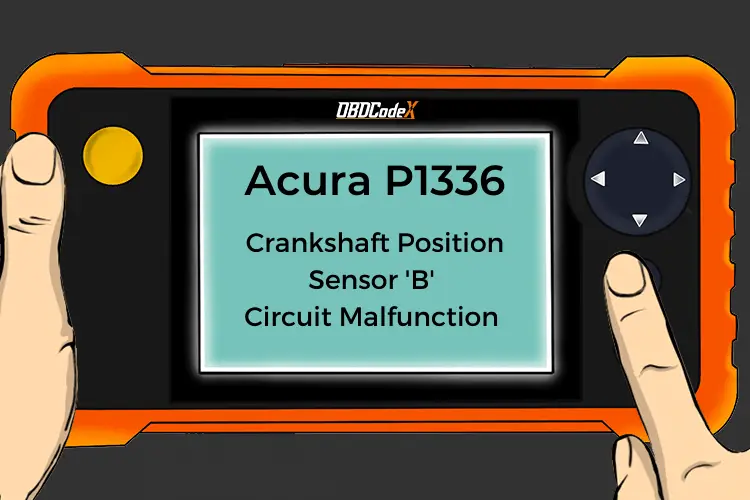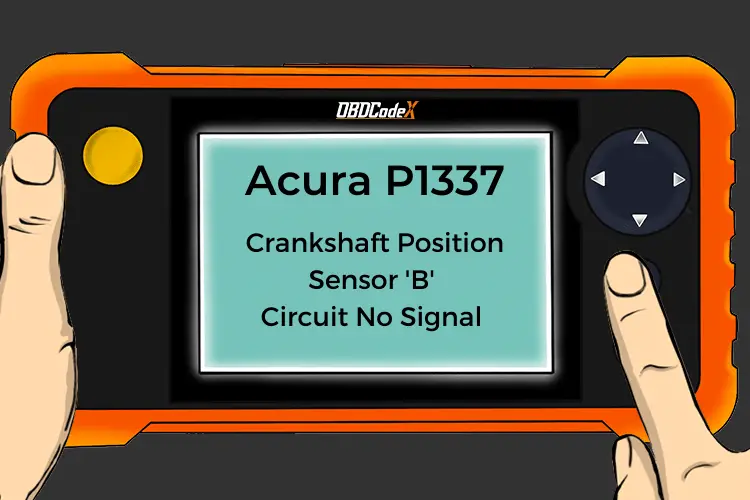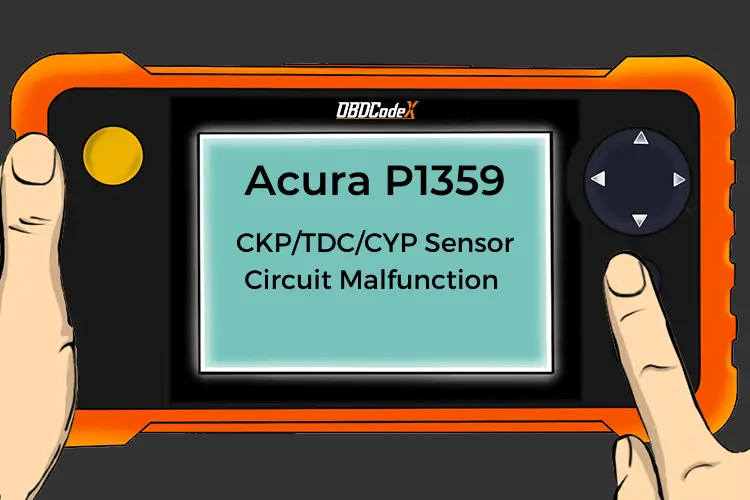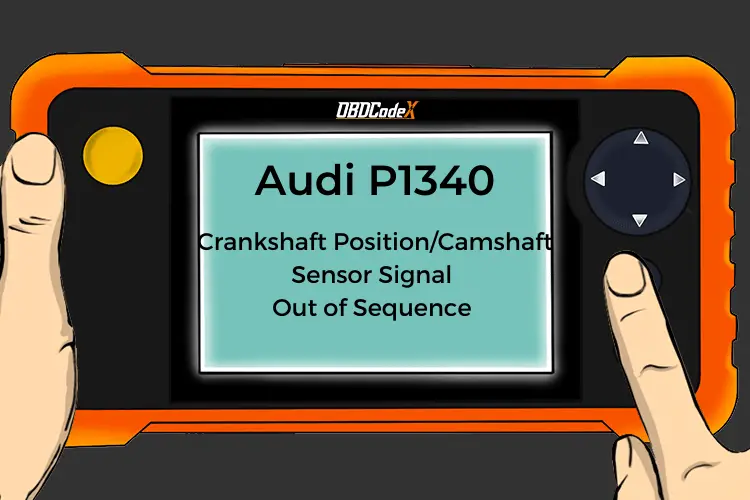P0388: Crankshaft Position Sensor B Circuit High Input
Is your scanner showing P0388?
No worries. We'll show you what it means and how to deal with it.
P0388: Crankshaft Position Sensor B Circuit High Input
OVERVIEWWhat Does The P0388 Code Mean?
In the past, when I have diagnosed a stored code P0388, it was due to the powertrain control module (PCM) detecting a high input voltage signal from the secondary crankshaft position (CKP) sensor. In a system which uses multiple CKP sensors, sensor B typically refers to a secondary CKP sensor.
CKP sensors monitor engine speed (RPM) and crankshaft position. The position of the crankshaft is used by the PCM to calculate ignition spark timing. The camshafts turn at half the speed of the crankshaft, so it is important that the PCM is able to distinguish between engine intake and exhaust stokes (rotations). The CKP sensor and each camshaft position (CMP) sensor have one or more circuits dedicated to providing the PCM with an input signal, a 5-volt reference signal, and a ground.
CKP sensors are typically of the electro magnetic, hall-effect variety and are mounted to the exterior of the engine. They are placed in very close proximity (usually only several thousandths of an inch) to a circuit completing engine ground. This engine ground is usually a reluctor ring (with precisely machined teeth) affixed to either end of the crankshaft or integrated into the crankshaft itself. Systems with multiple CMP sensors may use a reluctor ring on one end of the crankshaft and another machined into the center of the crankshaft.
Typically, the CKP sensor is mounted so that the crankshaft reluctor ring passes within several thousandths of an inch of its magnetic tip. As the crankshaft rotates, raised areas of the reluctor ring complete an electromagnetic circuit with the sensor. The indentations (between the raised areas) interrupt the circuit briefly. The PCM perceives these rapid circuit completions and interruptions as a waveform pattern representing voltage fluctuations.
The PCM constantly compares input signals from the crankshaft position and camshaft position sensor circuits. If CKP input voltage is too high over a set period of time, a P0388 code will be stored and a MIL may be illuminated.
Other crankshaft position sensor B trouble codes include P0385, P0386, P0387, and P0389.
What Are The Symptoms Of The P0388 Code?
Symptoms of this code may include:
- The engine will not start
- The tachometer (if equipped) does not register RPM when the engine is cranked
- Hesitation upon acceleration
- Poor engine performance
- Diminished fuel efficiency
What Are The Potential Causes Of The P0388 Code?
Potential causes for this code to set are:
- Defective CKP sensor
- Open or shorted wiring to the CKP sensor
- Corroded or fluid soaked connector at the CKP sensor
- Faulty PCM or PCM programming error
- Alternator overcharging and affecting PCM operation
How Serious Is This P0388 Code?
When a P0388 is stored, a no-start condition will likely accompany it. For that reason, this code should be categorized as severe. If the engine will start and run, there remains a high risk of a no-start condition in the near future.
How Can You Fix The P0388 Code?
Access to a suitable diagnostic scanner, with an integrated digital volt/ohmmeter (DVOM) and oscilloscope, will be needed before diagnosing a code P0388. As a reliable vehicle information source, I will also need access to All Data DIY.
Visually Inspect Of All System Related Wiring Harnesses And Connectors
Most successful code diagnoses begin with a visual inspection of all system related wiring harnesses and connectors. Petroleum based fluids can compromise the protective insulation on wiring and lead to shorted or open circuits (and a stored P0388), therefore circuits, electrical sensors, and/or connectors that have been contaminated with engine oil, coolant, or power steering fluid should be carefully inspected.
Retrieve Stored Trouble Codes
Connect the scanner to the vehicle diagnostic port to retrieve stored trouble codes and freeze frame data. Write this information down as it will help if the P0388 proves to be intermittent. Test-drive the vehicle (if possible) to see if the code is reset.
If It Is:
Locate a system wiring diagram from the vehicle information source and check for voltage at the CKP sensor. Typically a five-volt reference is used for CKP sensor operation but check manufacturer’s specifications for the vehicle in question. A ground signal and one or more output circuits should also be present. Proceed to the next step if reference voltage and ground signals are detected at the CKP sensor connector.
Using the DVOM, disconnect the electrical connector from the CKP sensor in question and test it according to manufacturer’s specifications. Replace the CKP sensor if resistance levels fail to comply with manufacturer’s specifications. If CKP sensor resistance values align with manufacturer’s specifications, continue to the next step.
After reconnecting the CKP sensor in question, attach the positive test lead of the oscilloscope to the signal output wire and connect the negative lead to the CKP sensor ground circuit. Power up the oscilloscope and select the appropriate voltage setting. Start the engine and observe the waveform pattern on the oscilloscope. Concentrate on unexpected spikes or glitches. If spikes or glitches are detected, carefully wiggle the wiring harness and connector for the CKP sensor in question to determine whether the problem is a loose connection or a defective sensor. I there is a broken or worn reluctor ring, or if the magnetic tip of the CKP sensor has excessive metallic debris attached, it may cause missing voltage blocks in the waveform pattern. Proceed to the next step if no problems are found in the waveform pattern.
Locate the PCM connector, insert the test leads of the oscilloscope to CKP sensor signal input and ground circuits, and observe the waveform pattern. Suspect an open or shorted circuit between the CKP sensor connector and the PCM connector if the waveform pattern near the PCM connector is dissimilar to what was seen when the test leads were connected near the CKP sensor. If this is the case, disconnect all related controllers and test individual circuits with the DVOM. Shorted or open circuits will need to be repaired or replaced. You may have a defective PCM or a PCM programming error if the waveform pattern is identical to what was seen when the test leads were connected near the CKP sensor.
Additional diagnostic notes:
- Some manufacturers recommend that CKP and CMP sensors are replaced as a set
- Use technical service bulletins to aid in the diagnostic process
Recommended Parts
Below are some recommended auto parts to help you address the trouble code affecting your vehicle and get it running smoothly again:
>>> Crankshaft Position Sensor
>>> WORKPRO 582-piece Crimp Terminals, Wire Connectors, Heat Shrink Tube, Electrical Repair Kit
>>> ECU
>>> KAIWEETS Digital Multimeter
>>> INNOVA 5210
>>> MakerHawk LCD Handheld Digital Oscilloscope
Note: During the purchasing process, please check carefully whether the part you want to buy fits your car!
Reference Sources
P0388: Crankshaft Position Sensor B Circuit High Input, OBD-Codes.




